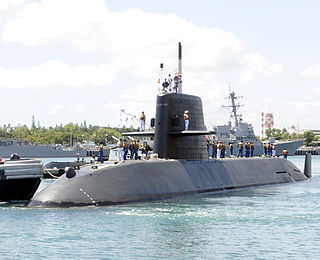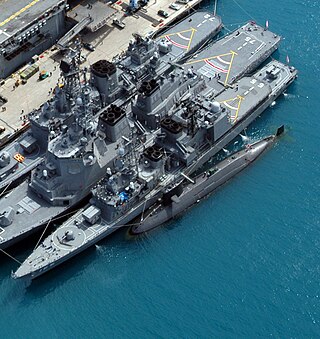
The Japan Maritime Self-Defense Force, abbreviated JMSDF, also simply known as the Japanese Navy, is the maritime warfare branch of the Japan Self-Defense Forces, tasked with the naval defense of Japan. The JMSDF was formed following the dissolution of the Imperial Japanese Navy (IJN) after World War II. The JMSDF has a fleet of 154 ships, 346 aircraft and 50,800 personnel.

Kawasaki Heavy Industries Ship & Offshore Structure Company is the shipbuilding subsidiary of Kawasaki Heavy Industries. It produces primarily specialized commercial vessels, including LNG carriers, LPG carriers, container ships, bulk carriers, oil tankers, as well as high speed passenger jetfoils. In addition, it is also a producer of warships for the Japan Maritime Self-Defense Force, including submarines. Kawasaki also produces marine machinery, including marine engines, thrusters, steering gears, deck and fishing machinery.

The Harushio class is a diesel-electric submarine class operated by the Japanese Maritime Self-Defense Force (JMSDF). The design is an evolution from the Yūshio class being slightly larger and with better noise reduction. Asashio, has been modified to test air-independent propulsion (AIP), and the remaining vessels were decommissioned and replaced by the Oyashio-class.

The Uzushio-class submarine was a series of seven submarines in service with Japanese Maritime Self Defense Force during the Cold War between 1972 and the mid-1990s. They were the first generation of the teardrop type submarine that valued the underwater performance against that of the preceding conventional-hull type Asashio class. Many were converted to training submarines (ATSS) towards the end of their lives.

JDS Ōshio (SS-561) was a submarine in service with Japanese Maritime Self Defense Force. Ōshio was planned and built to replace the aging JDS Kuroshio.

JS Hyūga (DDH-181) is the lead ship of the Hyūga-class helicopter destroyers of the Japan Maritime Self-Defense Force (JMSDF).

JS Uzushio (SS-592) is the third boat of the Oyashio-class submarines. She was commissioned on 9 March 2000.

JS Natsushio (SS-584) was the second ship of the Harushio-class submarines of Japan Maritime Self-Defense Force.

JS Hayashio (SS-585) was the third ship of theHarushio-class submarine of Japan Maritime Self-Defense Force.

JS Arashio (SS-586) was the fourth ship of theHarushio-class submarine of Japan Maritime Self-Defense Force.

JS Wakashio (SS-587) was the fifth ship of theHarushio-class submarine of Japan Maritime Self-Defense Force.

JS Fuyushio (SS-588) was the sixth ship of the Harushio-class submarines of Japan Maritime Self-Defense Force.

JS Asashio (SS-589) was the seventh ship of the Harushio-class submarine of Japan Maritime Self-Defense Force.

JDS Asashio (SS-562) was the lead boat of the Asashio-class submarines. She was commissioned on 13 October 1966.
JDS Harushio (SS-563) was the second boat of the Asashio-class submarines. She was commissioned on 1 December 1967.

JDS Uzushio (SS-566) was the lead boat of the Uzushio-class submarines. She was commissioned on 21 January 1971.

JDS Makishio (SS-567) was the second boat of the Uzushio-class submarines. She was commissioned on 2 February 1972.

JS Nichinan (AGS-5105) is the only ship of her type of oceanographic research ship for the Japan Maritime Self-Defense Force.

JDSHayabusa(PC-308) was a submarine chaser of the Japan Maritime Self-Defense Force (JMSDF) in the mid-1950s. She was later converted to an accommodation ship and redesignated as ASY-91. She was the third vessel to inherit the name after the Imperial Japanese Navy's Hayabusa-class torpedo boat Hayabusa and Ōtori-class torpedo boat Hayabusa.
















